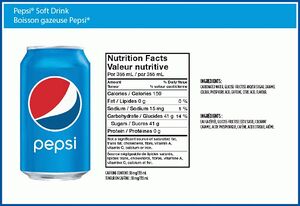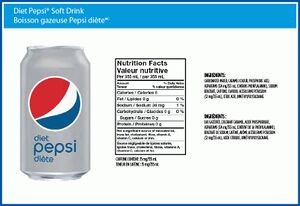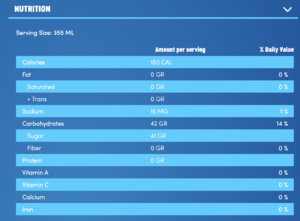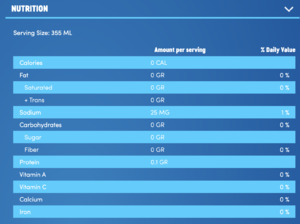Course:FNH200/Assignments/2020/Pepsi & Diet Pepsi
Pepsi and Diet Pepsi are carbonated soft-drink beverages originating from the same manufacturer, PepsiCo. The drink was founded in 1893 by Caleb Bradham in New Bern, North Carolina, United States and was initially called "Brad's Drink" which was then renamed to "Pepsi-Cola" in 1898 and finally called "Pepsi" in 1961.
Pepsi and Diet Pepsi are variants of the same product being an alternative to one another with Diet Pepsi offering a zero-calorie intake through artificial sweetening instead of regular sugar and Pepsi being the traditional variant.
Today, they are vastly available in all stores across the world and readily offered in all types of events ranging from sporting competitions to official conferences. The success has seen PepsiCo Inc. become one of the leading multinational food and beverage companies in the world generating sales of nearly 26 billion USD in 2017 alone.

Pictures

The regular Pepsi variant is the picture on top highlighting the aesthetic appearance of the product as well as the Nutrition Facts label in which the ingredient list is displayed.
An alternative to regular Pepsi is the Diet Pepsi variant and is the picture in the bottom highlighting the aesthetic appearance of the product as well as the Nutrition Facts label.
Ingredient lists
Ingredients
- Pepsi: Carbonated water, high-fructose corn syrup, and/or sugar, caramel colour, phosphoric acid, caffeine, citric acid and natural flavours.
- Diet Pepsi: Carbonated water, caramel colour, aspartame (124 mg/355 mL, contains phenylalanine), phosphoric acid, potassium benzoate (preserves freshness), caffeine, citric acid, natural flavour, acesulfame potassium (32 mg/355 mL).
Food Additives in Pepsi and Diet Pepsi
- High-fructose corn syrup (HFCS): A sweetener is made from corn starch, also known as glucose-fructose, isoglucose and glucose-fructose syrup. The starch is broken down into glucose by enzymes, and then some of its glucose is converted into fructose by glucose isomerase. HFCS 42, HFCS 55, and HFCS 90 refer to 42%, 55% and 90% fructose composition respectively, the rest being glucose and water.
- Caramel: A complex mixture of fat globules grouped in different sizes and surrounded by a high-concentration sugar solution in which milk solids-not-fat are distributed loosely. It is made by heating a mixture of glucose syrup, milk and vegetable fat to 118°C to 130°C. Heating can enhance the browning reaction and adjust the moisture content of the final product[1].
- Aspartame: A sugar substitute are about 200 times sweeter than sugar, but like sugar, it contains 4 calories per gram. Aspartame consists of phenylalanine and the amino acids aspartic acid, which are part of protein. After ingestion, aspartame decomposes into amino acids and methanol[2].
- Phenylalanine: an aromatic amino acid is important in the function and structure of many enzymes and proteins and plays a significant role in the biosynthesis of other amino acids[3]. Phenylalanine can cause brain damage, intellectual disabilities, seizures and other problems in people with Phenylketonurics.
- Phosphoric acid: a viscous transparent liquid or a colorless, odorless solid. It is used for anti-rust metal, beverage, food, fertilizer, detergent, and water treatment[4].
- Potassium benzoate (E212): the potassium salt of benzoic acid can inhibits the growth of mold, yeast and some bacteria and works best in low-pH products, below 4.5 (in the form of benzoic acid).
- Caffeine: a stimulant drug, which means it can speed up the transmission of information between the brain and the body. It’s found in the nuts, seeds and leaves of a number of different plants, including Cola acuminata (used in soft drinks).
- Citric acid: a weak acid with a pH of 3 to 6 has the chemical formula C6H8O7 and occurs naturally in citrus fruits such as lemon and lim
- Acesulfame potassium (Ace-K): a white crystal powder with a slightly bitter after-taste, which is one of the major artificial sweeteners.
- Dimethylpolysiloxan (also known as polydimethylsiloxane (PDMS) and dimethicone): Dimethylpolysiloxane is a compound known as a silicone. It’s a polymer – a large molecule made up of multiple smaller parts – that contains alternating silicon and oxygen atoms.
Roles of Food Additives in Pepsi and Diet Pepsi
- High-fructose corn syrup (HFCS): As a sweetener, HFCS 42 is mainly used in processed foods, cereals, baked goods, and some beverages. HFCS 55 is used primarily in soft drinks[5].
- Caramel: Caramel acts as the primary coloring agent of the product achieving the famous brown hue color found in many famous soda brands.
- Aspartame: Aspartame acts as a sugar substitute and serves the purpose of providing customers with alternative whether it is different product versions with less or no sugar or the fewer calories option.
- Phosphoric acid: Phosphoric acid is an additive used in sodas to promote and enhance the tangy flavor while increasing its acidity at the same time. In addition, phosphoric acid helps prevent growth of mold and bacteria that are easily able to multiple in sugary solutions.
- Potassium benzoate (E212): Potassium benzoate is a preservative used to mitigate the growth of bacteria, yeasts and molds to prolong the product’s shelf life.
- Caffeine: This synthetically produced additive generates a complex flavour profile as it boosts the product’s richness in flavour. Since only a small amount of caffeine is added, it does not primarily serve as a stimulant effect that usually act as an energy provider found in energy drinks but instead act as a flavour enhancer.
- Citric acid: Citric acid serves a similar purpose to phosphoric acid in a way that enhances the sharp, tangy taste of the product. Besides that, the citric acid reacts with baking soda found in the product to release carbon dioxide as gas and generate bubbles that typically contribute to the “soda experience”.
- Acesulfame potassium (Ace-K): A sugar substitute similar to aspartame but different in a sense that they offer different taste and calorie count. Acesulfame stimulates the sweet taste found in the product but is able to do so with lesser or no calorie present.
- Dimethylpolysiloxan: Polydimethylsiloxane is used as a lubricant and conditioning agent. It acts as an anti-foaming agent, skin conditioner, blocker and skin protectant. In Diet Pepsi, it functioned as an anti-foaming agent.
Pepsi vs. Diet Pepsi
Both Pepsi and Diet Pepsi have carbonated water, caramel colour, phosphoric acid, caffeine, citric acid and natural flavours in common. The difference between the two products are that Pepsi has high fructose and sugar while diet Pepsi uses aspartame, potassium benzoate, and acesulfame potassium in its ingredients.
Labels
The labels of Pepsi (original) and diet Pepsi (alternative) provide information in both official languages, English and French. Both products are labelled with the following information:
- common name of the product (Pepsi & Diet Pepsi)
- the medium-sized "smile" logo of PepsiCo (all Pepsi variants have been using the same logo since mid-2010)[6]
- name and address of PepsiCo
- a nutrition facts table[7] which gives information on (pictures on the right):
- an ingredient list which lists all the ingredients in the product by weight (it begins with the ingredients that weighs the most and ends with the ingredient that weighs the least)[7]
- a nutrition claim which describes the amount of nutrients in the product or positive effects of the product on people's health[8] (e.g. both Pepsi original and diet Pepsi have the same nutrition claim which states that they are "not a significant source of saturated fat, trans fat, cholesterol, fibre, vitamin A, vitamin C, calcium or iron")
- caffeine content of the beverage which should be expressed on the product label in milligrams (mg) of caffeine per stated serving size (e.g. both Pepsi and diet Pepsi have their caffeine content statement outside and directly beneath the nutrition facts panel which reads as "Caffeine Content: 35mg/355ml")[9]
- date markings[10]:
- packaging dates - "packaged on" dates are used on retail-packed foods with a durable life of 90 days or less, and must be accompanied by durable life information[10] (for best quality, consume unopened soda within 3 months; regularly, sodas can last 6-9 months[11][12])
- "best-before" dates - also known as durable life dates, which tell customers the anticipated amount of time that the unopened food product, when stored under appropriate conditions, will retain its freshness, taste, nutrition level, or any other qualities claimed by the manufacturers[10] (all of PepsiCo's products have "best taste dates" or "sell by dates" on the underside of cans, shoulders of bottles, and sides of paperboard wraps since 1994[13])
- storage instructions which recommend that the products should be stored in a cool place or tightly sealed containers and in the dark (sodas like Pepsi can stand from 2 to 25 ° C; it is important that there are no sudden temperature changes causing condensation on the package)
The Canadian Food Inspection Agency ensures the proper regulation of labeling by enforcing the Consumer Packaging and Labeling Act and Regulations. This act ensures that all products have packaged labels that display appropriate labeling, packaging, and advertising for any products consumed in Canada.[14] Both Pepsi and Diet Pepsi are included in this Act and Regulation, regardless of being an American-produced product[15]. These requirements for labeling are listed above and are included in the labeling of the Pepsi and diet Pepsi products. These requirements include; bilingual labeling, a common name prescribed by Food and Drug Regulations, Date marking and Storage Instructions, Identity and Principal Place of Business, Irradiated foods, Legibility and location, List of Ingredients and Nutrition Facts table, Net quantity of the foods, sweeteners, and other mandatory information like percent of alcohol or dairy. Pepsi and alternative product, Diet Pepsi, both adhere to these regulations, as stated above and displayed on the labeling.
References
- ↑ Sengar, G., & Sharma, H. K. (2014). Food caramels: a review. Journal of food science and technology, 51(9), 1686–1696. https://doi.org/10.1007/s13197-012-0633-z
- ↑ FoodInsight (November 1, 2018). "Everything You Need to Know About Aspartame". International Food Information Council (IFIC) Foundation.
- ↑ National Center for Biotechnology Information. PubChem Database. Phenylalanine, CID=6140, https://pubchem.ncbi.nlm.nih.gov/compound/Phenylalanine (accessed on July 20, 2020)
- ↑ "Hazardous Substance Fact Sheet" (PDF). New Jersey Department of Health and Senior Services. May 1997.
- ↑ "High Fructose Corn Syrup Questions and Answers". US Food and Drug Administration. January 4, 2018.
- ↑ Helm, Burt (April 23, 2009). "Blow Up Pepsi". BusinessWeek. Retrieved April 21, 2011.
- ↑ 7.0 7.1 Health Canada (November 27, 2019). "About food labels".
- ↑ Canadian Food Inspection Agency (January 12, 2012). "Nutrition claims".
- ↑ Health Canada (March 23, 2010). "Preliminary Guidance for Industry on the Labelling of Caffeine Content in Prepackaged Foods (March 2010)".
- ↑ 10.0 10.1 10.2 Canadian Food Inspection Agency (December 12, 2019). "Date labelling on pre-packaged foods".
- ↑ U.S. Department of Agriculture (July 17, 2019). "Ask USDA".
- ↑ "The Shelf Life of Soft Drinks".
- ↑ PepsiCo, Inc. "FAQ".
- ↑ "4.3 Food Labeling Requirements". Canvas. July 21, 2020. Retrieved July 21, 2020.
- ↑ "Pepsi". Pepsi. Retrieved July 21, 2020.
| This Food Science resource was created by Course:FNH200. |


